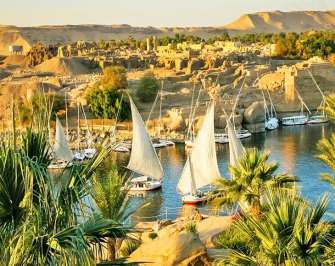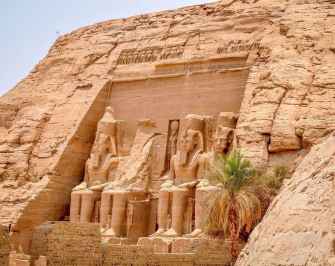11 Day Egypt adventure tour Package
From USD 1'700
+16 Additional options
► Day 1- Arrival in Cairo:
Once you arrive at Cairo Airport, Marsa Alam tours representative will be waiting for you to assist you in Baggage inspection procedures and passport check at the airport. Then he will lead you by a modern private air-conditioned vehicle to check in a hotel in Cairo.
overnight in Cairo
► Day 2-Giza Pyramids – Egyptian Museum:
start your Cairo day Tour to visit the Pyramids of Giza, visit the Great Pyramid of the king Cheops belonged to the four dynasties, visit Chephren & Mycerinus pyramids, then drive to the panorama area, take memorable photos of the three Pyramids together, continue visiting the Sphinx and the Valley Temple, Next tour to the Egyptian Museum including Tutankhamun treasures, Optional to visit the Mummy room, and Khan El Khalil Lunch at a local restaurant, vegetarian food available on request,
Overnight in Cairo.
► Day 3 - Old Cairo
Pick Up time from your hotel in Cairo or Giza at 08:00 am with your Egyptologist tour guide, you will drive up to the Saladin Citadel, constructed by Salah al-Din on the Moqattam Hills in 1183 AD as a defense against Crusader armies. Known for its fresh air and sweeping views of Cairo, it is now a preserved historic site of mosques and museums, including the Mosque of Muhammad Ali Pasha
Designed by the Turkish architect Yousif Boushnaq, who came to Cairo especially from Istanbul to build the great building, the mosque's alabaster structure stands in beautiful contrast to the sandstone city.
Lunch will be served in a local restaurant in Old Cairo
Then, visit Old Cairo to see major attractions such as the Hanging Church, the Ben Ezra Synagogue, the Church of St. Barbara, and the Church of Abu Serga, one of the oldest Coptic churches in Cairo
Continue to the Khan el-Khalili Bazaar, one of the oldest bazaars in the Middle East. Discover the old Cairo the center of Cairo ’s trading activities since the 14th century.
overnight in Cairo
► Day 4 Memphis and Sakkara Day tour
You will be picked up from your hotel by Marsa Alam tour guide to enjoy Cairo Day Tour to Memphis Sakkara and Dahshur Pyramids. You will start with the Step Pyramid at Sakkara, which is considered the world's oldest major stone structure. It was built in the 3rd Dynasty for King Djoser. Then Proceed to have your lunch at a local restaurant. After that transfer to Memphis which was founded by King Menes, and was the capital of Egypt during the Old Kingdom, it was considered to be a center of rule and culture for over 3000 years the first capital of Egypt, and see the Statue of Ramses II and the Alabaster Sphinx of Memphis. Then drive to Dahshur, Two of the later pyramids constructed here have been completely destroyed by time, and the elements and several others, such as the Black Pyramid (12th Dynasty, 1929-1885 BC), are badly damaged, but Dahshur also boasts two of Egypt’s best-preserved early pyramids. Both built during the reign of King Sneferu (2613-2589 BC), the founder of the 4th Dynasty, the Bent Pyramid, and the Red Pyramid at Dahshur are massive evidence of the architectural development that lead to the construction of the Great Pyramid and it companions at Giza. Then drive to your hotel.
overnight in Cairo
► Day 5 Alexandria
Drive to Alexandria (220 km/ 3 hours driving) to your hotel in central Alexandria facing the Corniche, Afterwards see some of the Graeco-Roman sites in Alexandria including
1- The Catacombs Kom el Shoqafa :
The Catacombs Kom el Shoqafa are hewn from the rock on the southern slopes of a hill, in the Carmous district. Thought to date from the 2nd century AD, they offer an admirable example of the characteristic Alexandria n fusion of Egyptian and Greco-Roman styles. Discovered in 1900 (thanks to a donkey falling into them)
2- Pompey pillar :
A massive 30m column looms over the debris of the glorious ancient settlement of Rhakotis, the original township from which Alexandria grew. Known as Pompey’s Pillar, for centuries the column, hewn from red Aswan granite, has been one of the city’s prime sights: a single, tapered shaft, 2.7m at its base and capped by a fine Corinthian capital. The column rises out of the sparse ruins of the Temple of Serapeum , a magnificent structure that stood here in ancient times.
3- The Roman Amphitheatre Kom el Dikka :
Kom Al Dikka was a well-off residential area in Graeco-Roman times, with lovely villas, bathhouses and a theatre. The area was known at the time as the Park of Pan, a pleasure garden where citizens of Alexandria could indulge in various lazy pursuits. Although the ruins aren't terribly impressive in scale, they remain a superbly preserved ode to the days of the centurion and include the 13 white-marble terraces of the only Roman amphitheatre found in Egypt.
4- Lunch in one of Alexandria Egyptian restaurant /Fish Market or Tikka with Great view to the Citadel and the Fishing Port.
then back to cairo
overnight in Cairo
► Day 6- Cairo- Aswan- Nile cruise
Pick up from your hotel in Cairo for a flight to Aswan and then to the Nile cruise
Embarkation& Lunch on board the Nile Cruise, proceed.
Visits of Aswan including the Temple of Philae and tour by Felucca around Elephantine, the High Dam, the Unfinished Obelisk
► Phiala temple:
Built to honor the goddess Isis, this was the last temple built in the classical Egyptian style. Construction began around 690 BC, and it was one of the last outposts where the goddess was worshipped.
► The high dam:
Aswan High Dam is a rock-fill dam located at the northern border between Egypt and Sudan. The dam is fed by the River Nile and the reservoir forms Lake Nasser. Construction for the project began in 1960 and was completed in 1968. It was officially inaugurated in 1971.
The Unfinished Obelisk :
Aswan was the source of ancient Egypt’s finest granite to make statues and embellish temples, pyramids, and obelisks. The large unfinished obelisk in the Northern Quarries has provided valuable insight into how these monuments were created, although the full construction process is still not entirely clear. Three sides of the shaft, nearly 42m long, were completed except for the inscriptions. At 1168 tonnes, the completed obelisk would have been the single heaviest piece of stone the Egyptians ever fashioned.
12:00 lunch on board the Cruise
at 16:00 optional tour sailing trip with Felucca around Elphinatine island and Visit Lord Kitchener island- Then visit the Nubian village
The Nubian village is one of Aswan's attractions. It's worth visiting and spending 2 hours. The place is very authentic and genuine, Colorful and artistic, the Nubian Village will surprise you in every corner! While walking in the village, you will straight away feel the soul of this place!
Dinner &overnight onboard the Cruise
Meals: Breakfast-Lunch-Dinner

► Day 7 Nubian Village - kom ombo
Breakfast & Lunch onboard the cruise. Do a Nubian village in the morning
13:00 sail to Kom Ombo
► Visit The temple of Kom Ombo
The temple and the associated settlement site located 40 K.m north of Aswan, the temple was dedicated to the deities Sobek and Horus and date mainly to the Ptolemaic and Roman period(332 B.b -395 A.c)
Sail to Edfu-Overnight in Edfu
Dinner &overnight onboard the Cruise
Galabyia Party.

► Day 8-Edfu and Luxor temples
Breakfast on the board on the Nile cruise, Breakfast on the Nile Cruise, Visit the Edfu around 08:00 by horse carriage
Edfu temple :
Upper Egyptian site dominated by a large well -Preserved temple, dedicated to the hawk-God Horus, The Construction of Ptolemaic temple of Horus, which was founded on the site of a much earlier temple, dated to the period between the reigns of Ptolemy the Third(246 B.c), The descriptions on the walls include the Myth of contending of Horus and Seth(Probably performed annually as a religious Drama
You will be back around 10:00
Lunch on the Cruise
At 10:30 Sail to Luxor through Esna lock
Arrive Luxor at 18:00
Visit Luxor temple.
► Luxor Temple:
Largely built by the New Kingdom Pharaoh Amenhotep the Third and Completed by King Tutankhamon and the Great King Ramses the second, The First pylon was raised by Ramses the second and Decorated with His Military Battle of Kadesh
Dinner &overnight on board the Cruise
Optional trip to the sound Light Karnak  temple - 40 $ P.P
temple - 40 $ P.P
Day 9- Luxor- Hurghada
Optional trip Balloon ride over the valley of the Kings 80 $ per person
Breakfast on the board on the Nile cruise, Breakfast on the Nile Cruise, Visit the west bank of Luxor and Karnak 
► The Valley of the Kings:
Once called the great Place of the Truth, this valley is Called now the valley of the Kings, It is a Majestic domain of the Pharaohs who once lay in great stone Sarcophagi, awaiting immortality, The isolated valley behind Deir el Bahri is dominated by the Pyramid-Shaped Mountain Peak
► The colossi of Memnon:
Massive pair statues Known as the Colossi of Memnon, Rising about 18 M from the plain, They are the remains of what was once the largest complex on the west bank, Built by Amenhotep the Third
The Queen Hatshepsut temple :
Rising out of the desert Plain, in a series of terraces, The temple of Hatshepsut Mergs with sheer limestone Cliffs of the eastern face of the Theban Mountain as if Nature herself had built this Extraordinary monument.
► Karnak :
Karnak is more than A temple, is a spectacular Complex of Sanctuaries, Kiosks, Pylons, and Obelisks, All dedicated to the Theban gods and to the Greater Glory of Egypt`s Pharaohs, Karnak was the Most Important place for the worship of the Theban Triad(Amun, Mut, and Khonso)
Lunch during the trip-
Meals: Breakfast- Lunch
Enjoy the sun and the sea at the resort in Hurghada
Day 10-Hurghada Free Day
Enjoy the sun and the sea at the resort in Hurghada
You can do an Optional trip to the dolphin house
Snorkeling trip to The dolphin house“ from Hurghada to have an experience of snorkeling and seeing a group of 60 - 80 dolphins will dance in front of your eyes and play with these amazing animals, and enjoy the deliciously prepared lunch by onboard your boat before getting back to your hotel.
overnight in Hurghada

Day 11-International departure
Transfer to Hurghada airport for a flight to cairo international airport for departure

Check out - transfer to Cairo airport for final departure. You can extend your stay in Cairo
Highlights
- ► Giza Pyramids
- ► Alexandria
- ► Memphis and Sakkara
- ► Old Cairo
- ► Cairo museum
- ► Philae temple
- ► Karnak
- ► Valley of Kings
- ► Abu Simbel
- ► Aswan High Dam
- ► Phialea temple
- ► Hatshepsut temple
- ► Madinet Habu
►Inclusions:
- ► Pick-up service at Cairo Airport.
- ► 5 nights in Cairo on a bed and breakfast basis.
- ► 3-night Nile cruise
- ► 2 Nights in a hotel Hurghada all-inclusive
- ► Flight tickets { Cairo – Aswan / Hurghada – Cairo }
- ► An escorted knowledgeable tour guide all over the tour.
- ► All your transportation during the tour with a private A.C car
- ► Entering fees to all the mentioned sightseeing on the itinerary.
- ► Private transfer from Luxor to Hurghaad
- ► All Service Charges and taxes.
► Exclusions:
- ► International Airfare.
- ► Egypt entry visa.
- ► Tipping
- ► Optional Tours
►Please remember to bring:
-
► Passports valid 6 months
- ► Hat
- ► Suncreams
- ► Sunglasses







